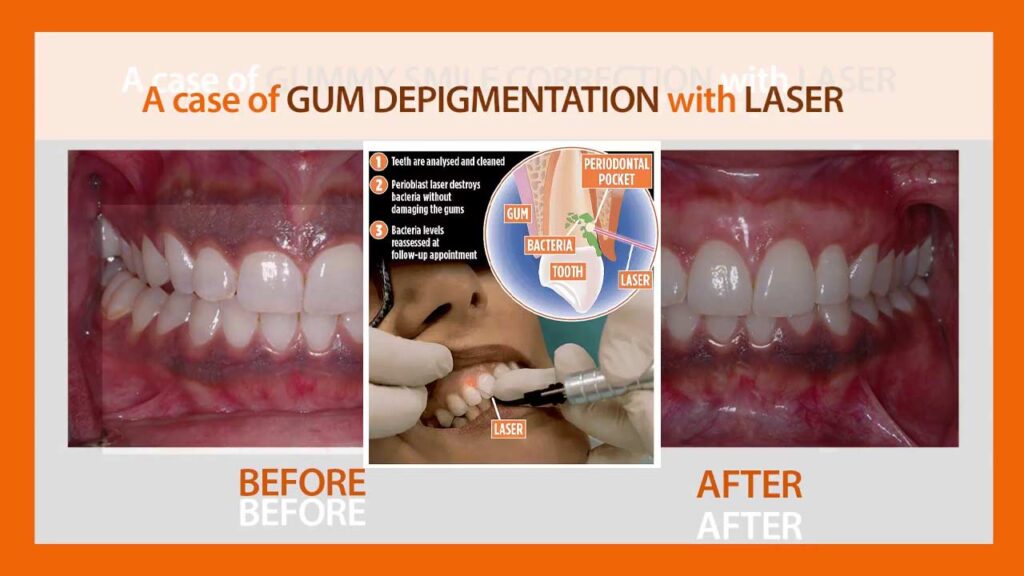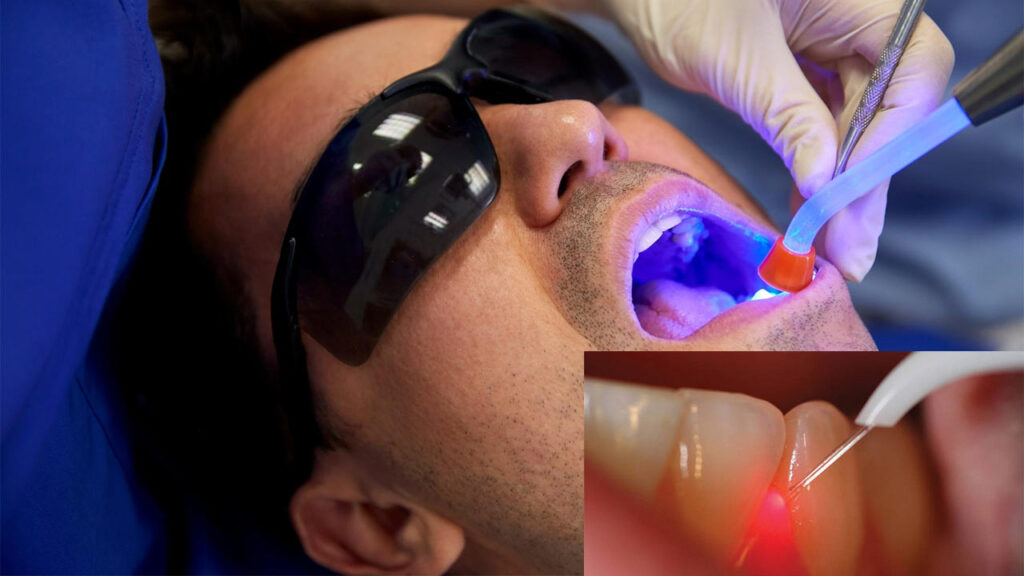Dental laser treatment is a modern technique that uses laser beams to perform various dental procedures. It can be used to treat tooth decay, gum disease, oral infections, and cosmetic issues. Dental laser treatment can offer many advantages over traditional methods, such as less pain, faster healing, and better results.
However, it also has some drawbacks, such as high cost, limited availability, and potential side effects. In this article, we will explain the risks and benefits of dental laser treatment. You will learn:
- What is dental laser treatment and how does it work
- What are the types of dental laser treatment and what are they used for?
- What are the pros and cons of dental laser treatment?
- How to prepare for and recover from dental laser treatment
- How to find a qualified dentist for dental laser treatment?
By reading this article, you will gain valuable and right information about dental laser treatment that will help you make an informed decision about your oral health.
What is Dental Laser Treatment and How Does It Work
Dental laser treatment is the use of lasers to treat various dental conditions. A laser is a device that produces a beam of light that has a specific wavelength and intensity. When this beam hits the tissue in the mouth, it causes a reaction that can either cut, vaporize, or coagulate the tissue. Depending on the type of laser and the procedure, the dentist can adjust the power, pulse, and duration of the laser beam to achieve the desired effect.
Dental laser treatment works by targeting specific tissues without affecting the surrounding areas. This reduces the damage to healthy tissue and minimizes bleeding, swelling, and infection. Dental laser treatment also stimulates the healing process by promoting blood clotting and tissue regeneration.

Dental laser treatment can be used for both hard tissue (teeth and bone) and soft tissue (gums and mucosa) procedures. However, different types of lasers are required for different types of tissues. The most common types of lasers used in dentistry are:
- Diode lasers: These are semiconductor lasers that produce light in the visible or near-infrared spectrum. They are mainly used for soft tissue procedures, such as gingivectomy, frenectomy, biopsy, and whitening.
- Carbon dioxide (CO2) lasers: These are gas lasers that produce light in the far-infrared spectrum. They are mainly used for soft tissue procedures, such as removal of tumors, lesions, or excess tissue.
- Erbium lasers: These are solid-state lasers that produce light in the near-infrared spectrum. They are mainly used for hard tissue procedures, such as cavity preparation, root canal therapy, or bone surgery.
- Neodymium-doped yttrium aluminum garnet (Nd:YAG) lasers: These are solid-state lasers that produce light in the near-infrared spectrum. They are mainly used for soft tissue procedures, such as periodontal therapy, hemostasis, or decontamination.
What are the Types of Dental Laser Treatment and What are They Used For
Dental laser treatment can be used for a variety of dental procedures, such as:
Cavity detection.
Lasers can detect cavities early by finding evidence of tooth decay.
Cavity preparation and filling.
Lasers can remove decayed tissue from a tooth without using a drill or anesthesia. Lasers can also kill bacteria in a cavity and bond the filling material to the tooth.
Root canal therapy.
Lasers can clean and disinfect the root canal system by removing infected pulp tissue and bacteria.
Gum disease treatment.
Lasers can remove plaque and tartar from below the gum line by vaporizing them. Lasers can also reshape or remove inflamed or diseased gum tissue.
Gum contouring.
Lasers can reshape or remove excess gum tissue to improve the appearance of a gummy smile or uneven gums.
Frenectomy.
Lasers can cut through the frenulum (the fold of skin that connects the tongue or lip to the mouth) to correct tongue-tie or lip-tie.
Biopsy.
Lasers can remove a small piece of tissue from the mouth for examination or diagnosis.
Tumor or lesion removal.
Lasers can remove benign or malignant tumors or lesions from the mouth or lips.
Teeth whitening.
Lasers can activate a bleaching agent applied to the teeth to speed up the whitening process.
Cold sore or canker sore treatment.
Lasers can reduce pain and inflammation from cold sores or canker sores by cauterizing them.
What are the Pros and Cons of Dental Laser Treatment?
Dental laser treatment has many benefits over traditional methods, but it also has some drawbacks. Here are some of the pros and cons of dental laser treatment:
Pros:
- Less pain: Dental laser treatment reduces pain by minimizing nerve stimulation and tissue damage. It also reduces the need for anesthesia or injections.
- Faster healing: Dental laser treatment stimulates blood clotting and tissue regeneration, which speeds up the healing process. It also reduces the risk of infection by sterilizing the treated area.
- Better results: Dental laser treatment improves the quality and accuracy of the procedure by targeting specific tissues without affecting the surrounding areas. It also preserves healthier tissue and prevents further damage.
- Less anxiety: Dental laser treatment reduces anxiety by eliminating the noise and vibration of a drill. It also creates a more comfortable and relaxing experience for the patient.
Cons:
- High cost: Dental laser treatment is more expensive than traditional methods, as it requires specialized equipment and training. It may not be covered by insurance or may have higher copays or deductibles.
- Limited availability: Dental laser treatment is not widely available, as not all dentists have the necessary equipment or expertise. It may be hard to find a qualified dentist for dental laser treatment in your area.
- Potential side effects: Dental laser treatment may cause some side effects, such as tooth sensitivity, gum irritation, or tissue burns. It may also interact with some medications or medical conditions, such as diabetes or blood disorders.
- Limited usefulness: Dental laser treatment cannot be used for all dental procedures, such as filling large cavities, placing crowns or bridges, or removing defective fillings. It may also require additional tools or techniques to complete the procedure.
How to Prepare for and Recover from Dental Laser Treatment
To prepare for and recover from dental laser treatment, you need to follow these steps:
- Before the procedure, consult your dentist about the details and expectations of the dental laser treatment. Ask them about the type of laser, the duration, the cost, the risks, and the benefits of the procedure. Inform them about any medications or medical conditions that you have, such as diabetes or blood disorders.
- During the procedure, follow your dentist’s instructions carefully. You may need to wear protective eyewear or a mouth guard to prevent injury from the laser beam. You may also need to rinse your mouth with water or an antiseptic solution before and after the procedure. You may feel some heat, pressure, or vibration from the laser, but you should not feel any pain. If you do, let your dentist know immediately.
- After the procedure, take care of your oral health and hygiene. You may experience some mild discomfort, swelling, or bleeding for a few days. You can use ice packs, painkillers, or anti-inflammatory drugs to relieve these symptoms. You can also rinse your mouth with salt water or an antiseptic solution to prevent infection. Avoid eating or drinking anything hot, cold, spicy, or acidic for a few days. Also avoid smoking, alcohol, or caffeine as they can delay healing and cause irritation.
- Follow up with your dentist regularly to monitor your healing and progress. You may need to have more than one session of dental laser treatment depending on your condition and goals. Your dentist will advise you on the frequency and duration of your treatment.
How to Find a Qualified Dentist for Dental Laser Treatment?
Finding a qualified dentist for dental laser treatment can be challenging, as not all dentists have the necessary equipment or expertise. Here are some tips on how to find a qualified dentist for dental laser treatment:
- Ask for referrals from your family, friends, or colleagues who have had dental laser treatment before. They can share their experiences and recommendations with you.
- Search online for dentists who offer dental laser treatment in your area. You can use websites such as [Dental Laser Directory] or [Academy of Laser Dentistry] to find certified dentists who specialize in dental laser treatment.
- Read reviews and testimonials from previous patients who have had dental laser treatment with the dentists you are considering. You can use websites such as [Yelp] or [Google] to find ratings and feedback from other customers.
- Contact the dentists you are interested in and ask them about their qualifications, experience, and services. You can also ask them for before-and-after photos or videos of their previous patients who have had dental laser treatment.
- Visit the dentists’ offices and check their equipment, facilities, and staff. You can also ask for a consultation or a trial session to see how they perform dental laser treatment.
Dental laser treatment is a modern technique that uses laser beams to perform various dental procedures. It can be used to treat tooth decay, gum disease, oral infections, and cosmetic issues.
Dental laser treatment can offer many advantages over traditional methods, such as less pain, faster healing, and better results. However, it also has some drawbacks, such as high cost, limited availability, and potential side effects.
In this article, we have explained the risks and benefits of dental laser treatment. We have also provided you with tips on how to prepare for and recover from dental laser treatment, how to choose the best dental products for people with eczema, and how to find a qualified dentist for dental laser treatment.
We hope you have found this article useful and informative. If you have any questions or need more assistance, please contact your dentist or dental hygienist.
